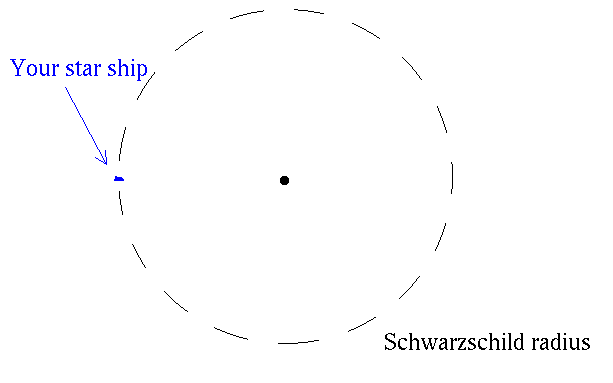Black hole basics.
If you put a lot of mass in a small volume, you will create a very strong
gravitational field. Even light is bent toward the center of the object
by its strong gravity.
With enough mass in the small volume, gravity is so strong that nothing,
not even light, can escape. That's a black hole.
Einstein's theory of gravity predicts the possibility of black holes. For
any radius R that you have in mind, the theory
tells how much mass M you have to have inside radius R in order for nothing
to be able to escape.
- For R = 30 km, the required mass is M = 10 Msun.
- For R = 3 x 106 km, the required mass is
M = 106 Msun.
A large black hole with no matter around it (a rather theoretical
object) is really quite benign.
- Say you went to visit a black hole with a mass M = 106 Msun.
- Then its ``Schwarzschild radius'' is R = 3 x 106 km.
- That's about 4 times the radius of the Sun.
- You just stop your starship a few AU away and drift in.
- If you weren't careful, you will have too much angular momentum
and you will simply go into orbit around it.
- You will stay in orbit forever, or until you fire your rocket
engines and go away.

- If you are very careful, your orbit will take you inside the
Schwarzschild radius.
- Nothing much happens as you cross the Schwarzschild radius.

- Once you are inside the Schwarzschild radius, you cannot
send messages to the outside.
- You very quickly fall way inside and are crushed by the gravational
forces.
- What happens to the atoms that you were made of? No one really
knows.
A large black hole in reality would probably have an ``accretion disk''
around it.

- Gas is orbiting in a disk around the black hole.
- It orbits slowly far away from the black hole, but very fast near the
black hole.
- It is heated by friction, losing gravitational potential energy and
getting very hot.
- As the gas loses losing gravitational potential energy it spirals
toward the black hole.
- Meanwhile, because it is so hot, it radiates photons.
- Since the black hole gravity is so strong, the matter in the accretion
disk has lots of gravitational potential energy to lose.
- Thus a black hole that is growing quickly should radiate enormous
amounts of energy.
- Also, there is enormous pressure on the inside of the disk.
- The pressure pushes matter out.
- Matter can't get out in the direction of the disk.
- But it can get out towards the poles.
- This should lead to jets of matter shot out of the central region
at high velocity.
Davison E. Soper, Institute of Theoretical Science,
University of Oregon, Eugene OR 97403 USA
soper@bovine.uoregon.edu




